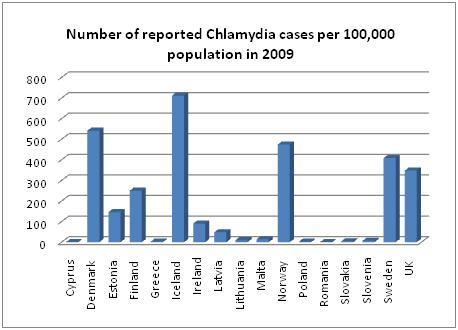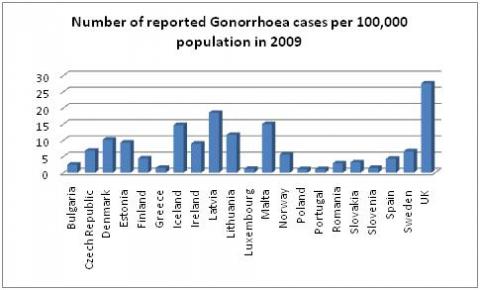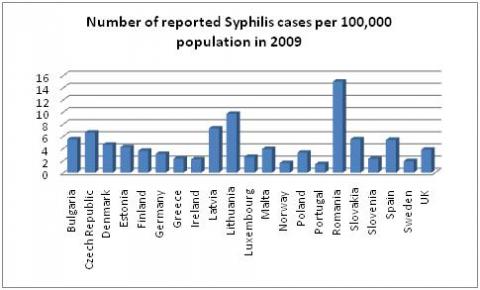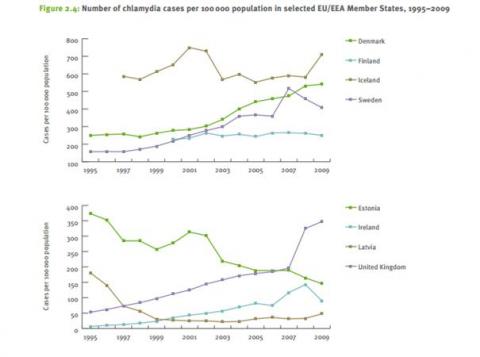Are we the STI capital of Europe?
"Generally people are more at risk in London than they are in wherever they were before. We're the STI capital of Europe."
Lisa Power, Policy Director at the Terrence Higgins Trust, in The Guardian, 7 August 2012
The consumption of vast quantities of condoms in the Olympic village has given the impression the athletes spend just as much time getting their legs over each other as they do over hurdles.
Speaking on the concomitant risks of an STI epidemic if such a sport occurred without suitable protective equipment, Lisa Power ranked London as top of the sexual disease table. But is this true?
Analysis
Unfortunately STI data is not readily available on different European cities, however the latest data from the Health Protection Agency tells us that London has the highest rates of STI diagnoses in the UK by a significant amount. What we can do is compare STI data for the UK with that of other European countries to at least guage how likely contracting an STI would be in the capital.
The European Centre for Disease Prevention and Control provides such data, and released its first survelliance report on STIs in Europe in 2011.
Members of the European Union and the European Economic Area (EU/EEA) submitted their STI data for the period 1990 — 2009, however due to differences in methodology and quality of countries' STI data, not all Member States were able to report comprehensive statistics.
The graphs below depict the latest (2009) data on the three major STI's (Gonorrhoea, Chlamydia and Syphilis) from countries who were able to respond.
Rather than simply recording the numbers of reported cases, the graphs take into account the range of population sizes in the different countries and show the various rates at which the STIs were reported in 2009:

The graph shows the massive variation in Chlamydia rates across Europe. Iceland towers over most of its competition with 711 cases per 100,000 people, whereas several other countries, including Romania, Cyprus and Greece have under 3 cases per 100,000.
The UK, however, trails in fifth place for Chlamydia rates. But for Gonorrhoea rates it stands above the rest:

The UK does not quite have the same dominance in Syphilis rates, where it remains comfortably in the middle:

Overall, therefore, the ECDC surveillance report indicates that the UK is not obviously the most STI-addled country in Europe, although remains relatively high in the rankings — at least for Gonorrhoea, Syphilis, and Chlamydia.
Caveats
However before anyone throws caution to the wind or cancels their holiday to Iceland, there are several reasons to pick up a pinch of salt along with your condom packet when looking at these statistics.
Firstly, as not all EU/EEA countries were able to provide the relevant data, we cannot be sure of the UK's true place on Europe STI rankings as whole.
Secondly, the STI data for each country could be affected by factors other than prevalence of the disease. The ECDC report warns that
"international comparisons are hampered by differences in surveillance systems because the quality and coverage of national surveillance are not consistent".
Low rates in many of the countries could be down to a lack of accurate diagnostic tools or accurate diagnostic or reporting capacity, rather than a genuinely low prevalence of STIs. For example, data on reported cases from Cyprian physicians is estimated to only reflect the 26 — 50 percent of all diagnoses, due to underreporting.
What's more, the report specifically offers an explanation for generally low rates in East and Central European countries. It suggests changes in healthcare systems and reporting routines might have increased the number of undiagnosed or unreported cases substantially.
The UK, on the other hand, has a relatively comprehensive system of STI reporting. To monitor Gonorrhoea and Syphilis rates, data is mandatorily collected from diagnoses made in genitourinary medicine (GUM) clinics (STI clinics).
This means that the UK's position over other countries could be largely due to its more effective STI diagnoses and reporting, rather than its disease-addled citizens.
In addition, the report notes that the UK's Chlamydia rate for 2009 is likely to be highly skewed by the change in reporting method introduced in 2008. In that year, the Chlamydia surveillance system included data collection from community-based test settings as well as GUM clinics. This means that Chlamydia diagnoses occurring outside of the clinics could be recorded and suddenly UK Chlamydia rates jumped.
This can be seen on the graph below:

This graph illustrates nicely how reporting methods can alter European data on STI prevalence drastically, and how UK's relatively high place among other European countries should be considered carefully.
Conclusion
Ms Power's original claim cannot be properly tested due to lack of comprehensive national STI data for European countries.
The latest surveillance report by the ECDC indicates that the UK is top-to-middling in overall rankings for Gonorrheoa, Chlamydia and Syphilis. However, due to the UK's relatively comprehensive STI data-collection and relatively poor coverage in Eastern and Central Europe, the UK's real standing is uncertain.